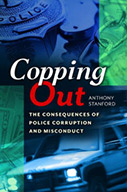Copping Out: The Consequences of Police Corruption and Misconduct

Author: Anthony Stanford
Publisher: Santa Barbara, CA: ABC-CLIO, 2015. 176p.
Reviewer: Peter A. Hanink | March 2016
In Copping Out, Anthony Stanford examines the timely and complex issues of police corruption and misconduct. Stanford approaches his subject with a reporter’s eye for detail and narrative. This is at once Copping Out’s greatest strength and its most frustrating shortcoming.
Stanford fills his chapters with extended histories of individual cases of police corruption, some well known and others obscure. In these accounts, he takes a “kitchen sink” approach, placing each within a richly detailed historical, political, and geographic context. However, frequently this richness overwhelms the larger points and significant factors are lost among more trivial details.
In the policing literature, police misconduct is typically divided into three categories: misfeasance, malfeasance, and nonfeasance. Misfeasance refers to inappropriate behavior on the part of police officers in the course of performing their duties (e.g. improperly searching a home without a search warrant or excessive force during an arrest). Malfeasance refers to illegal acts performed by the police (e.g. accepting bribes or stealing money taken as evidence). Nonfeasance refers to the failure to perform a required duty (e.g. failing to stop a speeding vehicle or failing to stop rioters from destroying property).
These distinctions are absent from Stanford’s analysis, and it suffers as a result. He sweeps within the catchall descriptors of “corruption” or “misconduct,” cases as varied as Jon Burge’s decades-long reign of terror in Chicago’s African American neighborhoods, and the present use of surveillance technologies by police departments.
Such a catholic understanding of misconduct provides a salutary departure from the stifling legalisms that often dominate police literature, and which fail to link the spectacular violence epitomized by beatings and forced confessions and the slow violence found in policies that disproportionately affect minority communities such as stop and frisk. For this, Stanford is to be commended.
By failing to distinguish between the types of police wrongdoing, however, the author runs the risk of lumping together the individual acts of officers from those that stem from systematic corruption. This aggregation suggests either that all such acts arise from a common source or worse, that such acts are inevitable and intractable.
This failure to attend to causality is perhaps Copping Out’s greatest weakness. The closest Stanford comes to addressing the causes of police misconduct is a brief discussion that features Lord Acton’s shopworn observation that “absolute power corrupts absolutely.” Such a line of reasoning casts police deviance as fundamentally different from the common deviance found among the general populace. It is beneficial to recall Hannah Arendt’s thesis that evil is banal. That is, that evil acts are human acts that have human causes.
There is a wealth of literature in the fields of criminology, sociology, and social psychology that seeks to understand the causes of anti-social, deviant behavior. Much of this literature has sought to understand why police officers commit acts, large and small, which go against their oaths and break the law. To be sure, there remain fierce debates among police scholars, and no one theory has ever been found to adequately explain such behavior. It would be unfair to ask Stanford to discover that which has eluded generations of scholars.
And to be fair, from the outset, the author sets out to explore the consequences of misconduct, not its causes. But by failing to attend to questions of causality, Copping Out can read like a parade of horribles: an endless series of inexplicable atrocities performed by inscrutable evildoers. As such, it is unsurprising that he asks little of us other than to agree that police corruption and misconduct results in injustices and erodes public confidence in the police. Here to, his failure to include a theoretical, causal framework within his analysis undermines his project.
In the second chapter, Stanford offers a history of police corruption with special attention paid to how police departments have been co-opted by criminal enterprises and political machines. He recounts how once these cases of corruption have been uncovered, police departments lose the support of the public.
What this narrative leaves out however, is how the police recovered the public’s support in the periods between the scandals. This is no small thing. In focusing on how trust in the police is lost, but not in how it is regained, the reader is ultimately left asking why, given the litany of corruption and violence the author has recounted, the police retain any support at all.
Stanford’s analysis seems to suggest that public support for the police has a natural level to which it returns after it has been lost. This ignores the role played by civil rights activists, politicians, consent decrees, Presidential commissions, lawsuits, and police reforms in restoring lost trust. More relevant to an academic reader, it ignores the growing body of literature by scholars such as Tom Tyler on the relationship between procedural fairness and legitimacy. This literature suggests that the police gain or lose legitimacy depending upon whether citizens feel as if they have been treated fairly and have had their concerns heard.
The bulk of police reforms in recent decades have focused on transparency, professionalization, and community outreach. To the extent to which such reforms have helped restore faith in the police, a procedural fairness perspective helps to explain what Stanford cannot. More significantly perhaps, to the extent to which such reforms have failed to curb aggressive policing tactics that lead many minorities to believe that the police unfairly target their communities, a procedural fairness perspective helps to explain why minorities tend to trust the police less often than their white counterparts.
Ultimately, the reader is left feeling as if Stanford is avoiding making a larger point. While he certainly addresses the ways in which systematic and pervasive racism infect police departments, his analysis begins and ends with individuals: Chicago Mayor Richard M. Daley, Jon Burge and his “Midnight Crew,” the LAPD’s Rampart Division, and so on.
The most compelling portions of Copping Out are those in which the author discusses his personal experiences in the aftermath of the death of Chicago Black Panther leaders Fred Hampton and Mark Clark at the hands of the police. The violence he describes is neither that of the corrupt cop who has been bought by the mob nor that of the overzealous racist. Rather, it is a response to a racialized threat by a power structure resistant to and fearful of change. One is left wishing that Copping Out had focused more on telling this story.
Peter A. Hanink is a lawyer and PhD student at the University of California, Irvine. His research focuses on race and policing.


